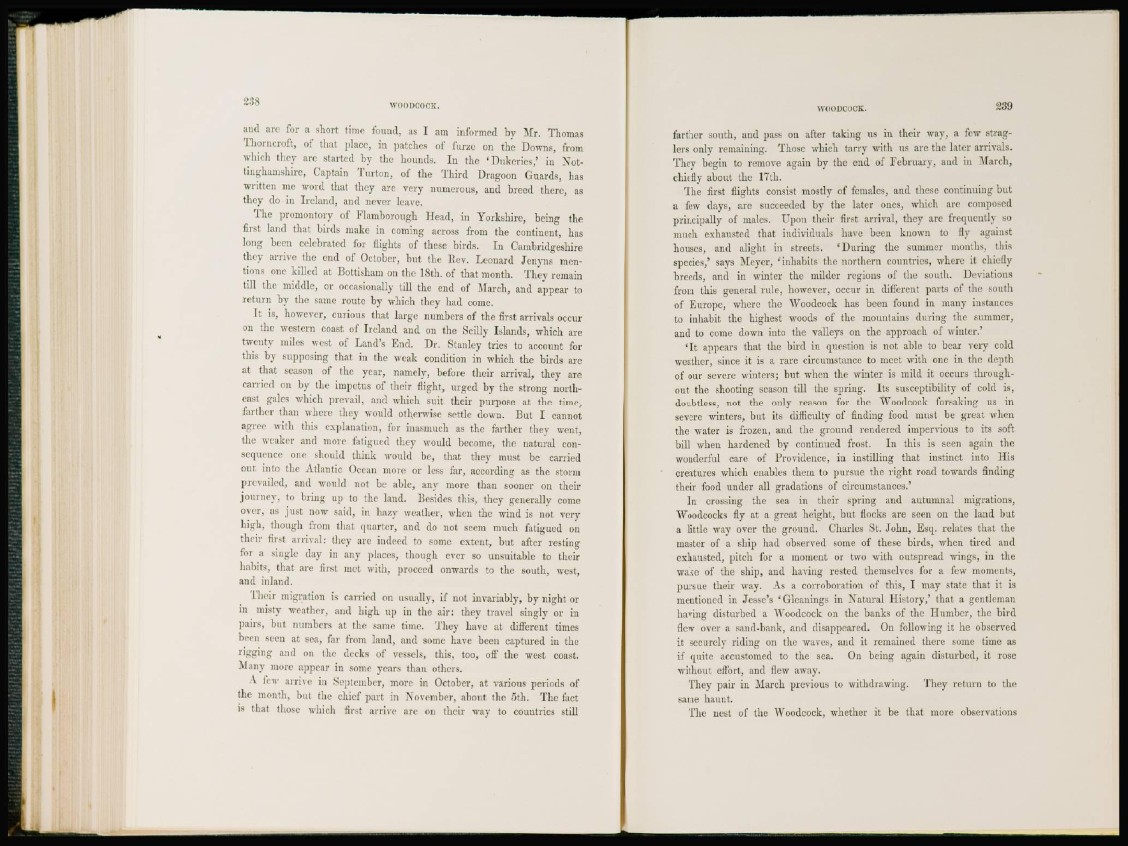
WOODCOCK.
and arc for a short time found, as I am informed by Mr. Thomas
Thorn croft, of that place, in patches of furze on the Downs, from
which they arc started by the hounds. In the 'Dukeries,' in Nottinghamshire,
Captain Turton, of the Third Dragoon Guards, has
written me word that they are very numerous, and breed there, as
they do in Ireland, and never leave.
The promontory of Flamborough Head, in Yorkshire, being the
first land that birds make in coming across from the continent, has
long been celebrated for flights of these birds. In Cambridgeshire
they arrive the end of October, but the Rev. Leonard Jenyns mentions
one killed at Bottisham on the 18th. of that month. They remain
till the middle, or occasionally till the end of March, and appear to
return by the same route by which they had come.
I t is, however, curious that large numbers of the first arrivals occur
on the western coast of Ireland and on the Scilly Islands, which are
twenty miles west of Land's End. Dr. Stanley tries to account for
this by supposing that in the weak condition in which the birds are
at that season of the year, namely, before their arrival, they are
carried on by the impetus of their flight, urged by the strong northeast
gales which prevail, and which suit their purpose at the time,
farther than where they would otherwise settle down. But I cannot
agree with this explanation, for inasmuch as the farther they went,
tin1 weaker and more fatigued they would become, the natural eonsequence
one should think would be, that they must be carried
out into the Atlantic Ocean more or less far, according as the storm
prevailed, and would not be able, any more than sooner on their
journey, to bring rip to the land. Besides this, they generally come
over, as just now said, in hazy weather, when the wind is not very
high, though from that quarter, and do not seem much fatigued on
their first arrival: they are indeed to some extent, but after resting
for a single day in any places, though ever so unsuitable to their
habits, that are first met with, proceed onwards to the south, west,
and inland.
Their migration is carried on usually, if not invariably, by night or
in misty weather, and high up in the air: they travel singly or in
pairs, but numbers at the same time. They have at different times
been seen at sea, far from land, and some have been captured in the
rigging and on the decks of vessels, this, too, off the west coast.
Many more appear in some years than others.
A i'ew arrive in September, more in October, at various periods of
the month, but the chief part in November, about the 5th. The fact
is that those which first arrive are on their way to countries still
WOODCOCK.
farther south, and pass on after taking us in their way, a few straglers
only remaining. Those which tarry with us are the later arrivals.
They begin to remove again by the end of February, and in March,
chiefly about the 17th.
The first flights consist mostly of females, and these continuing but
a few days, are succeeded by the later ones, which are composed
principally of males. Upon their first arrival, they are frequently so
much exhausted that individuals have been known to fly against
houses, and alight in streets. (D u r i n g the summer months, this
species,* says Meyer, 'inhabits the northern countries, where it chiefly
breeds, and in winter the milder regions of the south. Deviations
from this general rule, however, occur in different parts of the south
of Europe, where the Woodcock has been found in many instances
to inhabit the highest woods of the mountains during the summer,
and to come down into the valleys on the approach of winter.'
' I t appears that the bird in question is not able to bear very cold
weather, since it is a rare circumstance to meet with one in the depth
of our severe winters; but when the winter is mild it occurs throughout
the shooting season till the spring. Its susceptibility of cold is,
doubtless, not the only reason for the Woodcock forsaking us in
severe winters, but its difficulty of finding food must be great when
the water is frozen, and the ground rendered impervious to its soft
bill when hardened by continued frost. In this is seen again the
wonderful care of Providence, in instilling that instinct into His
creatures which enables them to pursue the right road towards finding
their food under all gradations of circumstances.'
I n crossing the sea in their spring and autumnal migrations,
Woodcocks fly at a great height, hut flocks are seem on the land but
a little way over the ground. Charles St. John, Esq. relates that the
master of a ship had observed some of these birds, when tired and
exhausted, pitch for a moment or two with outspread wings, in the
wake of the ship, and having rested themselves for a few moments,
pursue their way. As a corroboration of this, I may state that it is
mentioned in Jesse's 'Gleanings in Natural History,' that a gentleman
having disturbed a Woodcock on the banks of the Humber, the bird
flew over a sand-bank, and disappeared. On following it he observed
it securely riding on the waves, and it remained there some time as
if quite accustomed to the sea. On being again disturbed, it rose
without effort, and flew away.
They pair in March previous to withdrawing. They return to the
same haunt.
The nest of the Woodcock, whether it be that more observations